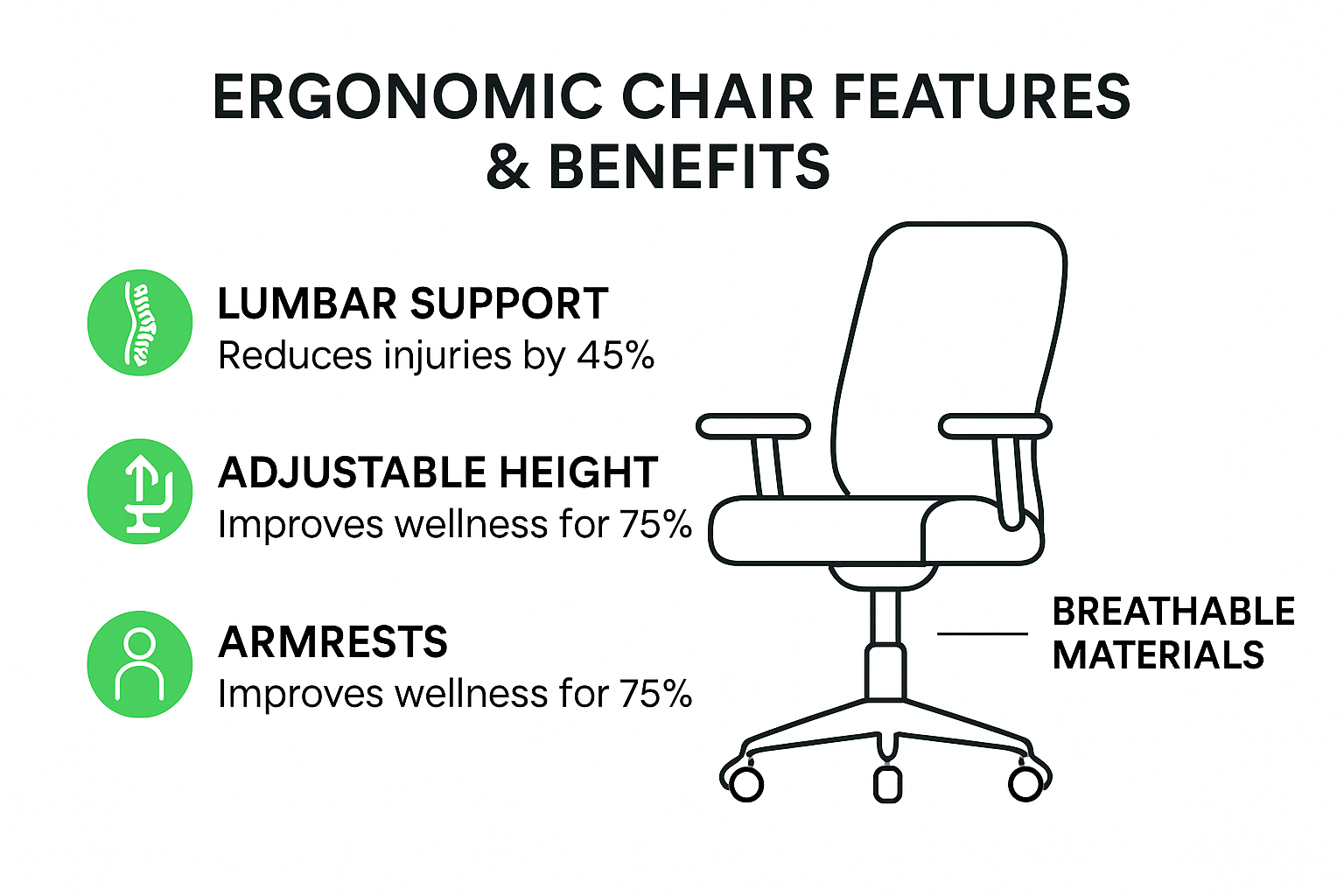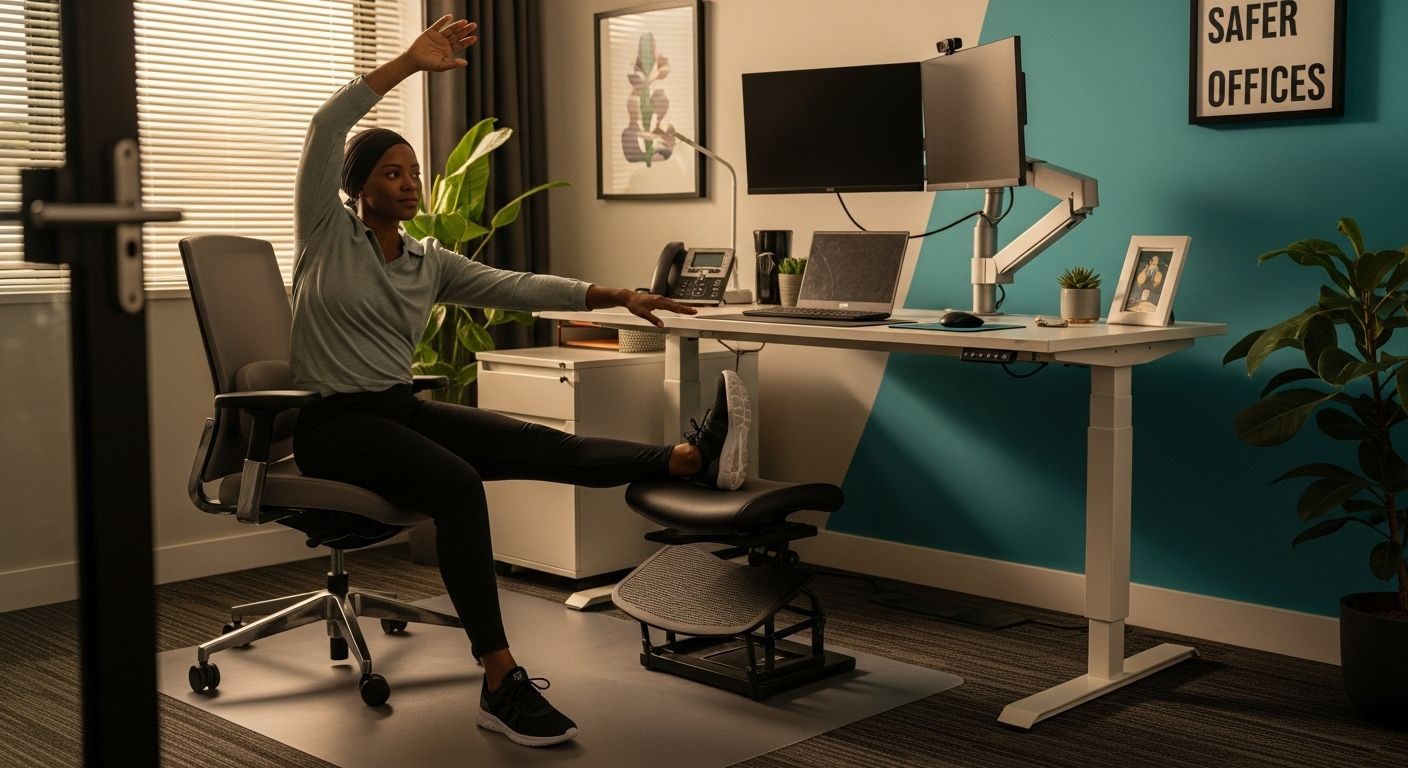Employee Health and Office Furniture: A 2025 Guide for Southern Africa
Aug 04, 2025
Employee Health and Office Furniture: A 2025 Guide for Southern Africa

People spend an average of over 90,000 hours at work in their lifetime, and much of that time is spent sitting at a desk. Most folks reckon a fancy chair or desk is just about style or brand. Not true. The real story is that your office furniture can make or break your health, costing you days off and even risking long-term injury in ways most people never see coming.
Table of Contents
- How Office Furniture Impacts Employee Health
- Key Office Furniture Choices For Healthier Workplaces
- Boosting Productivity And Wellness In Southern Africa
- Practical Steps For Safer And Healthier Offices
Quick Summary
| Takeaway | Explanation |
|---|---|
| Invest in ergonomic office furniture. | Ergonomic designs support body alignment, reducing physical strain and the risk of disorders. |
| Implement dynamic workstations. | Sit-stand desks promote movement and prevent health issues linked to prolonged sitting. |
| Conduct regular workplace assessments. | Regular assessments address environmental factors impacting employee well-being, enhancing comfort and productivity. |
| Provide comprehensive ergonomic training. | Ongoing education on furniture use and posture encourages healthier work habits and reduces injury risk. |
| Adopt a holistic wellness approach. | Integrate psychological and social aspects of health for a thriving workplace environment that boosts engagement and productivity. |
How Office Furniture Impacts Employee Health
Employee health is intricately connected to the physical environment where work happens, with office furniture playing a critical role in determining overall wellness and productivity. Modern workplaces are increasingly recognizing that furniture is not merely about aesthetics but a fundamental component of employee well-being and performance.
Ergonomic Design and Physical Health
Ergonomic office furniture directly influences an employee’s physical health by supporting proper body alignment and reducing strain. Research from the International Journal of Environmental Research and Public Health reveals that poorly designed workstations contribute significantly to musculoskeletal disorders, including chronic back pain, neck tension, and repetitive stress injuries. Chairs with inadequate lumbar support, desks at incorrect heights, and non-adjustable workstations can lead to long-term health complications.
Proper ergonomic furniture helps mitigate these risks by:
- Promoting correct posture to reduce skeletal and muscular stress
- Minimizing physical strain during extended work periods
- Supporting natural body movements and reducing potential injury risks
Psychological Impact of Workspace Design
Beyond physical health, office furniture significantly influences psychological well-being. According to OSHA guidelines, a well-designed workspace can reduce stress, enhance mental clarity, and improve overall job satisfaction. Comfortable, thoughtfully arranged furniture creates an environment that supports employee motivation and reduces workplace anxiety.
Employees who feel physically comfortable are more likely to maintain higher levels of concentration, creativity, and engagement. This psychological comfort translates directly into improved productivity and reduced absenteeism. Read our guide on creating optimal workspaces for more insights into employee wellness strategies.
Implementing ergonomic furniture is not just a health intervention but a strategic investment in human capital. By prioritizing employee comfort and physical well-being through intelligent furniture selection, organizations can create environments that support both individual health and collective performance.
Key Office Furniture Choices for Healthier Workplaces
Selecting the right office furniture is crucial for creating a workspace that supports employee health, productivity, and overall well-being. Strategic furniture choices go beyond aesthetic considerations, serving as fundamental tools for maintaining physical and mental wellness in the modern workplace.
Ergonomic Chairs: The Foundation of Workplace Comfort
Research from the Washington State Department of Labor & Industries highlights the critical importance of ergonomic chairs in preventing workplace injuries. An ideal ergonomic chair should provide comprehensive support, featuring adjustable elements that accommodate individual body types and working styles. Key features include:
- Lumbar support that maintains natural spine curvature
- Adjustable seat height to ensure proper leg and foot positioning
- Armrests that support forearms and reduce shoulder strain
- Breathable materials that promote comfort during extended work periods

Here’s a table summarizing the essential features of ergonomic chairs and their health benefits:
| Feature | Health Benefit |
|---|---|
| Lumbar Support | Maintains spine’s natural curve, preventing back pain |
| Adjustable Seat Height | Promotes proper leg & foot positioning, reducing leg strain |
| Armrests | Reduces shoulder and neck tension |
| Breathable Materials | Increases comfort during long hours |
| Adjustable Backrest | Supports different body shapes & movements |
Dynamic Workstations: Promoting Movement and Flexibility
According to the CDC’s National Institute for Occupational Safety and Health, static working positions contribute significantly to health risks. Sit-stand desks represent a revolutionary solution to this challenge. These dynamic workstations allow employees to alternate between sitting and standing, reducing the negative health impacts of prolonged sedentary behavior.
The benefits of adjustable workstations include:
- Reduced risk of musculoskeletal disorders
- Improved blood circulation
- Enhanced energy levels and mental alertness
- Decreased risk of obesity and related health complications
Explore our expert workspace solutions to understand how furniture can transform workplace wellness.
Complementary Ergonomic Accessories
A study in the Journal of Occupational and Environmental Medicine emphasizes the importance of comprehensive ergonomic solutions. Beyond chairs and desks, additional accessories play a crucial role in creating a health-focused workspace. Ergonomic keyboard trays, monitor stands, footrests, and document holders can significantly reduce physical strain and support proper body alignment.
These complementary accessories help employees maintain optimal posture, reduce eye strain, and minimize repetitive stress injuries. By investing in a holistic approach to office furniture, organizations demonstrate a commitment to employee health that extends far beyond basic workplace requirements.
Boosting Productivity and Wellness in Southern Africa
In the dynamic business landscape of Southern Africa, companies are increasingly recognizing the critical connection between workplace design, employee wellness, and organizational productivity. The region’s progressive approach to workplace solutions demonstrates a sophisticated understanding of how strategic office furniture can transform work environments and drive economic performance.
Local Workplace Wellness Strategies
Research from the International Journal of Environmental Research and Public Health highlights that thoughtfully designed workspaces directly correlate with enhanced employee performance. Southern African businesses are pioneering innovative approaches to wellness that integrate ergonomic furniture solutions with comprehensive health strategies.
Key strategies include:
- Customized workspace configurations that accommodate diverse employee needs
- Cultural sensitivity in furniture design and workplace accommodations
- Adaptive technologies supporting varied work styles and physical requirements
- Local manufacturing initiatives promoting sustainable office furniture solutions
Below is a table outlining innovative workplace wellness strategies in Southern Africa and their intended outcomes:
| Strategy | Intended Outcome |
|---|---|
| Customized workspace configurations | Supports diverse individual needs |
| Cultural sensitivity in design | Increases inclusivity and employee satisfaction |
| Adaptive technologies | Enhances flexibility for various work styles |
| Local manufacturing initiatives | Promotes sustainability and supports local economy |
Economic Implications of Workplace Wellness
Employer investments in ergonomic furniture represent more than aesthetic improvements. These strategic choices yield significant economic benefits by reducing healthcare costs, minimizing workplace injuries, and enhancing overall productivity. Southern African organizations understand that employee wellness is a critical competitive advantage in a rapidly evolving global marketplace.
The financial rationale for investing in employee health includes:
- Reduced absenteeism
- Lower healthcare and compensation expenses
- Improved employee retention
- Enhanced organizational reputation
Learn about our workplace wellness approach and discover how strategic furniture choices can transform your organization.
Technological Integration and Future Trends
Southern African businesses are at the forefront of integrating advanced technological solutions with ergonomic furniture design. Smart workstations featuring adjustable configurations, integrated health monitoring systems, and personalized ergonomic settings represent the cutting edge of workplace innovation.
Future trends indicate a holistic approach to workplace design that considers:
- Mental health and psychological comfort
- Technology-enabled adaptable workspaces
- Sustainable and locally sourced furniture solutions
- Inclusive design principles accommodating diverse workforce needs
By prioritizing employee wellness through intelligent furniture choices, Southern African organizations are not just creating comfortable workspaces but building resilient, high-performing work cultures that can compete on the global stage.
Practical Steps for Safer and Healthier Offices
Creating a safe and healthy office environment requires a comprehensive approach that goes beyond selecting appropriate furniture. Organizations must implement strategic interventions that address multiple aspects of workplace wellness, ensuring employees can perform at their best while maintaining their physical and mental health.
Workplace Environment Assessment
According to WorkSafe Victoria, a thorough workplace environment assessment is fundamental to creating a healthy office space. This comprehensive evaluation involves analyzing key environmental factors that directly impact employee well-being:
- Lighting quality ensuring optimal visual comfort
- Noise control to minimize auditory stress
- Thermal comfort maintaining appropriate temperature ranges
- Air quality monitoring and improving ventilation systems
By systematically addressing these elements, organizations can create a workspace that supports both physical health and cognitive performance. Regular assessments help identify potential risks and implement proactive solutions before they become significant health concerns.
Ergonomic Implementation and Training
The CDC’s National Institute for Occupational Safety and Health emphasizes the importance of comprehensive ergonomic interventions. Implementing an effective ergonomic program involves more than providing appropriate furniture—it requires ongoing education and personalized support.
Key components of an effective ergonomic implementation strategy include:
- Individual workstation assessments
- Personalized ergonomic training sessions
- Regular follow-up evaluations
- Encouraging movement and posture variation
Discover our comprehensive workplace wellness solutions to understand how targeted interventions can transform your office environment.
Holistic Wellness Approach
A truly effective office wellness strategy transcends physical infrastructure, integrating psychological and social dimensions of employee health. This holistic approach recognizes that workplace wellness is a complex interplay of environmental, physical, and mental factors.
Practical implementation strategies include:
- Establishing dedicated relaxation areas
- Promoting regular breaks and movement
- Implementing mental health support programs
- Creating collaborative spaces that encourage social interaction
- Providing flexible working arrangements
By adopting a multifaceted approach to workplace wellness, organizations can create environments that not only prevent health issues but actively promote employee well-being, engagement, and productivity. The goal is to develop workspaces that serve as catalysts for individual and collective success, reflecting a forward-thinking approach to human resource management.

Frequently Asked Questions
How does ergonomic office furniture impact employee health?
Ergonomic office furniture supports proper body alignment, reducing strain and preventing musculoskeletal disorders like back pain and repetitive stress injuries, thus promoting overall physical health in the workplace.
What are the benefits of dynamic workstations like sit-stand desks?
Dynamic workstations allow employees to alternate between sitting and standing, which helps reduce the health risks associated with prolonged sitting, improves circulation, enhances energy levels, and can lead to increased productivity.
Why is it important to conduct regular workplace assessments?
Regular workplace assessments help identify environmental factors that may negatively impact employee well-being, enabling organizations to implement proactive solutions that enhance comfort, productivity, and overall health.
What complementary accessories can enhance the ergonomic setup of an office?
Complementary accessories such as ergonomic keyboard trays, monitor stands, footrests, and document holders help maintain proper posture, reduce eye strain, and minimize repetitive stress injuries, further supporting a healthy workplace environment.
Transform Your Workspace Health with Office Stock
You have just learned how outdated office setups can hurt employee health and productivity, causing back pain, stress, and constant discomfort. Many Southern African offices still struggle with rising absenteeism and low motivation because of poor workspace design. Imagine how much more you could achieve with modern ergonomic solutions and supportive environments that actually help your team thrive every day.

Act now and give your staff the comfort and flexibility they deserve. Explore the full range of premium ergonomic chairs, sit-stand desks, and smart accessories at Office Stock. Let our expert team help you tailor a healthy office environment that supports wellness and drives high performance. Visit our website today to get started on a safer, more productive workspace.
